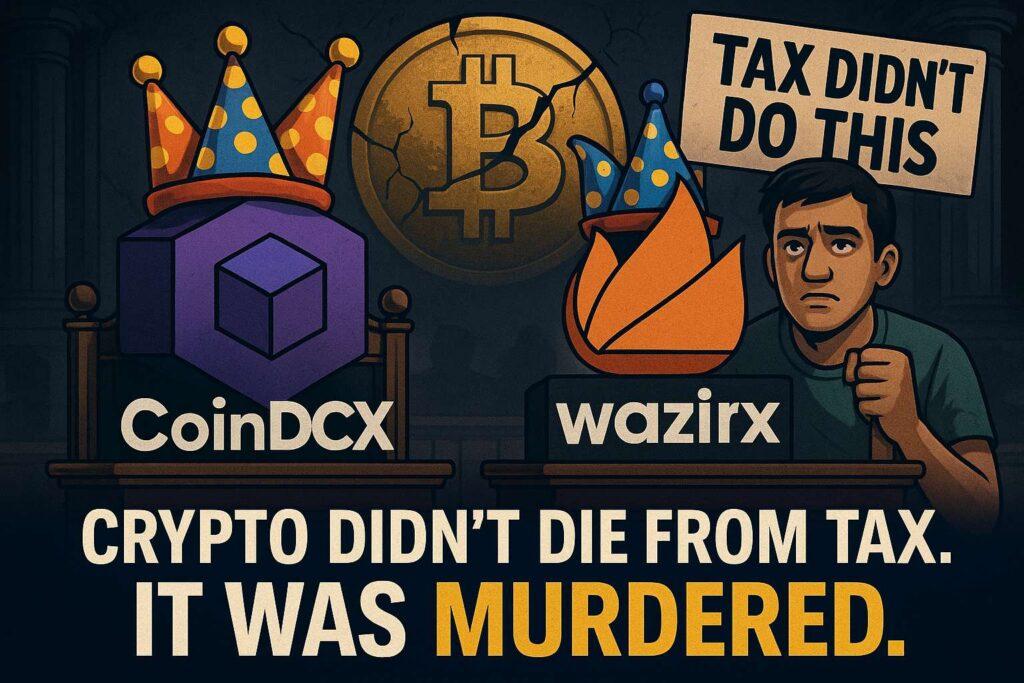🎯 At a Glance
While most folks blame India’s 1% TDS and 30% tax for crypto’s downfall, the real culprits were two homegrown crypto darlings who promised decentralization but delivered disaster: CoinDCX and WazirX.
1. Introduction: How to Kill an Industry in 2 Hacks
Crypto in India didn’t die because of the government. It died because of bad code, worse disclosure, and exchanges run like mom-and-pop shops with billion-dollar user trust.
- WazirX: $235 million gone, blamed on North Korea.
- CoinDCX: $44 million stolen, 18-hour delay in disclosure.
Result? An entire country’s faith in Web3 evaporated faster than a Binance listing.
2. CoinDCX: Hacked and Then Ghosted
- Hack Date: July 18, 2025
- Damage: ₹368–378 Cr stolen (~$44M), treasury hit—not users (lucky?)
- Problem: CoinDCX took 17 hours to even admit it.
- Response: “We’ve launched India’s biggest bounty.”
Oh, fantastic—here’s $11M if someone helps us fix what we should’ve secured in the first place.
This wasn’t a glitch. It was a revelation. India’s so-called safest exchange? Cracked like a cheap ledger.
3. WazirX: The Titanic of Indian Crypto
- Hack Date: July 18, 2024
- Damage: $235 million
- Victims: 15 million users, frozen funds, broken lives
- Blame Game: WazirX said Binance was responsible. Binance laughed.
- Regulators: Still circling. Delhi High Court: “You can’t just say sorry.”
This was the moment Indian crypto entered irreversible coma.
4. No, It’s NOT the Taxes
Let’s get this straight:
- 30% tax on gains? Harsh, but manageable.
- 1% TDS? Annoying, but doesn’t kill markets.
But you know what does kill an industry? - Getting robbed.
- Not knowing if your funds are safe.
- Watching founders gaslight you with Web3 buzzwords post-hack.
5. Where’s the Transparency?
Imagine if HDFC Bank got hacked and waited 18 hours to say anything.
That’s what CoinDCX did.
WazirX? They never really disclosed exact losses until forced by on-chain data analysts.
Blockchain may be trustless—but exchanges aren’t supposed to be.
6. India’s ‘Crypto Scene’ Aftermath
- Trading volumes down 90% since WazirX collapse
- Retail participation dead
- VDA exchanges now glorified quiz apps with reels and token offers
- Even CoinSwitch, the cleanest of the lot, is struggling for user traction
The taxman didn’t kill crypto. The industry shot itself in the face—twice.
7. Why CoinDCX & WazirX Ruined It for Everyone
- They were the face of Indian crypto
- They were on hoardings, IPL jerseys, finance podcasts
- They told regulators: “Trust us, we’ve got it covered”
And then they got hacked, ran silent, and played blame bingo.
8. What Happens Now?
- CoinDCX might survive with institutional backing—but credibility is in tatters
- WazirX? Still flailing in court, reputation in ICU
- RBI has more ammo than ever to say, “See? Told you so”
- G20, FATF, SEBI all watching—and writing new rules
- Retail users? Moved to Binance, Coinbase, or just plain gave up
9. Lessons That Will Probably Be Ignored
- Secure your damn wallets
- Don’t use one hot wallet for $40M
- Be transparent before Twitter finds out
- Stop playing Web3 startup with Web2 hygiene
And for god’s sake, stop saying “your funds are SAFU” after every breach. It’s insulting.
10. Blame Where It’s Due
Not taxes. Not SEBI. Not the RBI.
The downfall of crypto in India has two logos:
- The orange flame of WazirX
- The purple cube of CoinDCX
These platforms were too big to be this careless.
11. So Who Wins?
- Offshore platforms like Binance, Kraken: Gain Indian users
- CBDC (Digital Rupee): Gets regulatory backing, no competition
- Finfluencers: Pivot to “gold vs stocks” now
- Retail traders: Exit, re-enter later—or never
12. Final Thoughts: This Was Self-Destruction
Crypto’s not banned. But it is broken. Not because of policy—but because of two exchanges that forgot the golden rule:
If you hold people’s money, you better secure it like your life depends on it.
Because in crypto, your brand’s life actually does.
Written by EduInvesting Team | July 22, 2025
Tags: CoinDCX hack, WazirX collapse, crypto downfall, not taxes, Indian crypto, blockchain trust, VDA security flaws



















